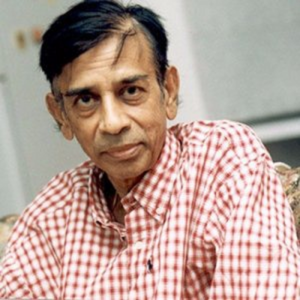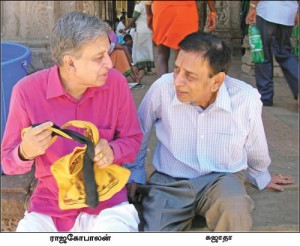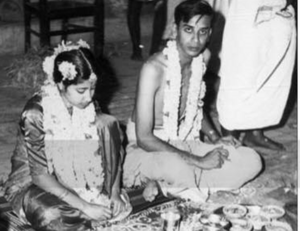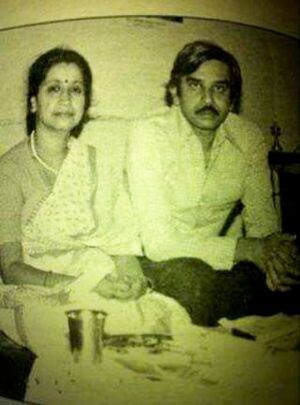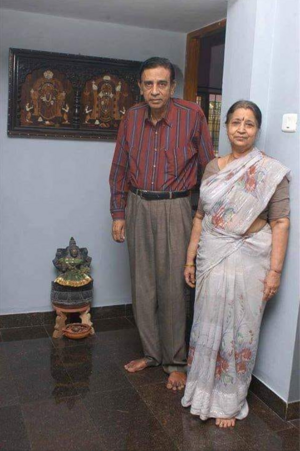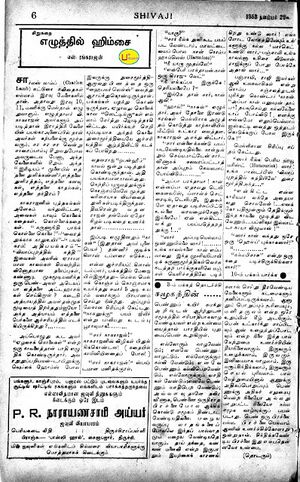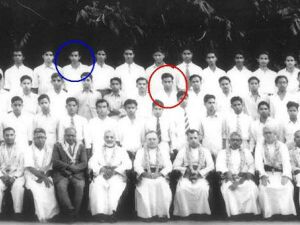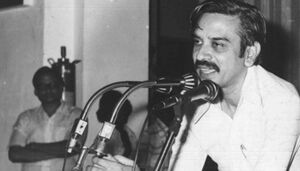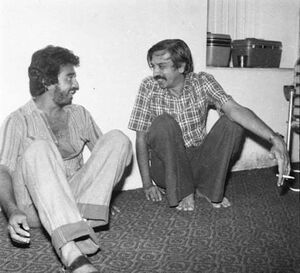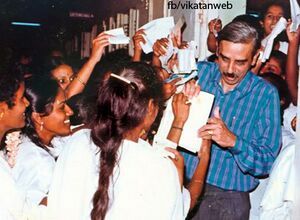Sujatha
இந்தப் பக்கத்தை தமிழில் வாசிக்க: சுஜாதா
Sujatha (May 3, 1935 - February 27, 2008) was a Tamil writer. He wrote serialized fiction and short stories for the common reader, and authored many popular columns in periodicals. He brought innovation to Tamil prose and pioneered science fiction in the language. He is also known for his essays introducing science and classical Tamil literature to the common reader.
He was an electronics engineer and was part of the team that invented the Indian Electronic Voting Machine (EVM).
Within the landscape of popular writers, Sujatha was a luminary, next only to Kalki.His writing style, like Kalki's, was a page turner. He wrote prolifically across various forms and formats. He had a huge reader base in Tamil and a line of proteges who followed in his style of writing.
Early Life and Education
Sujatha's given name was S. Rangarajan. He was born on 3 May 1935 in a house located in South Street in the Theppakulam area of Tiruvallikeni, Chennai. His father, Srinivasa Raghavan, worked in the Electricity Board. His mother, Kannamma, came from a wealthy family. Sujatha's elder brother, Krishnamachari, was a doctor. His younger brother, Rajagopalan, retired as Chief General Manager of the Tamil Nadu division of the Telephone Department. Rajagopalan was also a Vaishnavite scholar and wrote commentary on the Brahma Sutras. Sujatha’s younger sister, Viji, died at the age of three, when Sujatha was eleven.
Sujatha's paternal grandparents were Kuvalakudi Singamayankar and Rukmini Ammal. When his father was posted in the interiors of the state as part of his work at the electricity department, Sujatha lived at his grandmother's house in Srirangam and continued his studies. After completing his schooling at The Higher Secondary School for Boys in Srirangam, Sujatha went to St. Joseph's College in the neighbouring city of Trichy. He studied there from 1952 to 1954 and graduated with a B.Sc. in Physics. He then did a Masters in Electronics Engineering at the Madras Institute of Technology (MIT). Dr. A.P.J Abdul Kalam, who later became President of India, studied with him at Trichy and MIT. Sujatha won a prize for his article on Infinite Mathematics and Kalam won another for his article on building aircrafts.
Personal Life
After completing the engineering course, he wrote the engineering examination conducted by the central government and placed second nationally. He joined the national radio as a trainee and later worked as Air Traffic Controller in the Civil Aviation Department at Meenambakkam, Chennai. He rose to the level of the Chief Technical Officer and served in Delhi for fourteen years.
In 1970, he joined Bharat Electronics Limited (BEL) in Bangalore as Assistant Manager. He then took charge as General Manager of its R&D division and worked on designing the Electronic Voting Machine. He also took part in a study of missile technology. Although he was previously involved in films, he became a full-time screenwriter only after his retirement in 1993.
On 28 January 1963, at the age of 27, Rangarajan married Sujatha. He later adopted his wife's name as an allonym. The couple's first child, a baby girl, died within a year. Later, they had two sons, Ranga Prasad and Keshava Prasad.
Literary Life
Sujatha learned classical Tamil literature from his grandfather and the hymns of Alvars from his grandmother. He ran hand-written magazines in Srirangam, in his youth, along with Srinivasan Rangarajan who later became a film lyricist under the pseudonym Vaali. Joseph Chinnappa, his English lecturer at St. Joseph's College, Trichy, introduced him to British short stories and poetry. Ayyam Perumal Konar, a Tamil teacher and the author of the famous Konar Notes (a study guide), introduced him to classical Tamil literature.
Sujatha wrote his first story under his real name, S. Rangarajan. The story titled Ezhuthil Himsai was published in 1953 in the zine Sivaji run by Triloka Sitaram from Trichy. The magazine counted eminent writers like Ku. Pa. Rajagopalan as its contributors.
Later, when he moved to Delhi, he befriended N.S. Jegannathan, Indira Parthasarathy, the editor of the Kanaiyazhi magazine K. Kasthurirangan. Sujatha started writing a column in the last pages of Kanayazhi, started by Kasturirangan in July 1956, under the name Srirangam S.R. The column was variously titled, Neerkumizhigal, Petti, and Kadaisipakkam, until finally, the name Kadaisipakkam stuck. These articles were compiled and published by Visa Publications.
When Kumudam published Shushma Enge, a story written by his friend and edited by Sujatha, it sparked in him a desire to write. His short story Idadhu Orathil was published in 1962 under the name S. Rangarajan in Kumudham.
In the anthology Kurukshethram compiled by Nakulan, Sujatha wrote Thanimai Kondu, which is considered one of the best short stories in Tamil. He expanded on the same story and wrote its serialized version under the title Nylon Kayiru in Kumudam in August 1968. Originally named Seetu Maligai, he later changed the name to Nylon Kayiru. While writing this story, he assumed the allonym Sujatha for the first time. Another writer by the name R.K. Rangarajan was also writing in Kumudam at that time. Sujatha said that he had used a pseudonym so as to not be confused with the other writer. In another instance, he said that he disliked the old ring to the name Rangarajan and hence adopted the modern name of Sujatha. In reality, he chose the allonym as it was against his employment rules to write for the outside world, given that his government job was intricately linked to defense technology.
Ganesh-Vasanth
Sujatha’s writing style and the world he created in his detective stories became very popular. The most popular detective characters he created were lawyer Ganesh and his assistant Vasanth. Ganesh made his debut in 1968 in Sujatha's first serialized fiction, Nylon Kayiru. Vasant later appeared in the novel Priya in 1973 (see Ganesh, Vasanth).
Short Stories
Sujatha wrote short stories anthologized under the titles Madyamar, Srirangathu Devathaigal and Thoondil Kathaigal.
Science
Sujatha was a pioneering writer who introduced science fiction stories in Tamil. They were published as standalone collections too. Sujatha's style consisted of writing dazzling mysteries imbued with elements of science. Sujatha'sarticles and Q&As on science have contributed immensely to the spread of science among the general public in Tamil. His Ean Etharku Eppadi, is an acclaimed collection of columns that explains scientific facts. Through them, Sujatha emerges as a scientist who believed in empiricisim and the creative power of technology.
Plays
Sujatha was inspired by American realist playwrights Arthur Miller and Tennessee Williams. His plays like Dr. Narendranin Vinoda Vazhakku (Dr. Narendra's Bizarre Case) and Singamayankar’s Peran (Singamayankar's Grandson) have reached literary prominence through his unexaggeratedportrayal of everyday life and their natural dialogue.
Classical Literature
Sujatha wrote books explaining the Thirukkural and Sangam poetry in simple, contemporary Tamil. His explanatory notes on Alvar's hymns are noteworthy.
Style
After Bharathi and the Pudhumaipithan, Sujatha's writing style is considered to be the most influential in modern Tamil. Even though he adopted this style to appeal to the general public, it influenced many writers in serious literature too. There were three cornerstones to his writing:
- Externality - Sujatha focused on portraying the outside world and building the storyline through external detail.
- Minimalist - Sujatha's writing was characterized by brevity in descriptions of scenes and events.
- Playfulness - In Sujatha's writing, the author's voice was always playful. His language was laden with humor and sarcasm.
The pioneering Tamil writers, Pudhumaipithan and Ashokamitran, influenced him. Amongst the Western world, literary writers like Ernest Hemingway and John Updike, and popular fiction writers like Frederick Forsyth were his influences. Sujatha used Updike’s techniques of word arrangements, the liberal use of ellipsis to indicate silence and distorting nouns into verbs. He followed Hemingway’s technique of using pithy descriptions of the external world by borrowing unusual similes from other fields like aeronautics (cobalt blue sky, for instance). Sujatha also employed subtle parody in his stories, achieved by quirks of language in the style of Kurt Vonnegut.
Sujata's style went beyond mere technique because it was enriched by his extensive reading and keen observation. He was a careful student of the varied ways in which language is expressed; he studied Sangam literature and the hymns of Alvars; he observed keenly the terminologies used in law and commerce, the spoken language in Chennai and Trichy, and the lingo of modern literature. He borrowed from these varied expressions in his writing, and made it his own. His style demands careful reading due to its versatility. In this aspect, only Pudhumaipithan can be regarded his equal. This depth in his writing was also the reason for the profound effect his writing had on the next generation.
Journalism
- Sujatha was the editor of the Kumudam magazine for three years.
- He was the editor of the online journals Minnambalam and Ambalam.
Filmography
The first novel of Sujatha's to be made into a film was Gayatri (1977). Then he started writing dialogues for movies. The first film for which he wrote dialogue was Ninaithale Inikkum (1979). Sujatha worked as a writer in thirty films.
Sujatha joined hands with the entrepreneur, 'Pentafour' Chandrasekaran and founded Media Dreams, a film production company. Media Dreams produced Bharathi (2000), Nila Kaalam (2001), Little John (2001), Pandavar Bhoomi (2001) amongst other films.
Controversies
In 1980, Sujatha started writing a novel, Sivappu Karuppu Veluppu in Kumudam. Violent protests erupted, claiming that the story insulted the Nadar community, forcing Sujatha to apologize. Kumudam stopped publishing the novel. Later, he wrote the novel under the name Ratham Ore Niram without any caste references.
Awards
- In 1993, he received an award from Government of India's National Council for Science and Technology for making science accessible to the public
- VASVIK Award for his efforts in creating the Electronic Voting Machine.
- The Kalaimamani Award by the Government of Tamil Nadu.
Sujatha has not won any literary awards of note.
Death
Sujatha passed away on 27 February 2008 in Chennai. He was being treated for kidney failure for some years.
Memories
- Uyirmmai Padhippagam presents the Sujatha Awards for Literature annually.
- The Tamil writer, Ira. Murugan wrote a biography of Sujatha for the Sahitya Akademi
Literary Significance
Sujatha's literary significance originates primarily from the influence his style had on other Tamil writers. There were two styles that preceded him in the context of Tamil literature. In popular fiction, on the one hand, there was Kalki's simple prose, which spoke directly to the reader, and on the other, Chandilyan's ornate prose. In the modern literary context, Ashokamitran’s realistic writing, which narrated things as they were, and Sundara Ramaswamy’s witty and satirical prose were the two dominant styles. Sujatha’s writing, embellished with a plethora of external symbols was humorous and playful. This way of writing, which was steeped in the external world, suited the narration of modern life.
Sujatha’s vision resonated with the readers of the eighties. The political intensity that prevailed globally in the seventies dissipated during the eighties. The new generation, was apolitical and believed in science and technology. They had replaced the preoccupation with politics with an interest in science. Hence, Sujatha was a writer after their own heart.
The use of technology in mystery stories is what gave the tag of science fiction to Sujatha's works. Unlike the best science fiction writing in the world, they were neither based on scientific principles nor did they use the images of science to explore fundamental questions about life. However, they were important in that they pioneered the genre in Tamil.
"Amongst Sujatha’s short stories, the ones that portray the middle class life without fuss, have a literary quality to them. His plays too are literary works set in the aesthetic of realism," says Jeyamohan.
Works
Novels
In alphabetical order.
- Apsara
- Anitha Ilam Manaivi , Kumari Publications, Nagapattinam - 611001
- Anithavin Kadhalgal
- Aa...!
- Aadhalinal Kadhal Seiveer
- Ayiraththil Iruvar
- Unnai Kanda Neramellam, Kumari Publications, Nagapattinam - 611001
- Ethaiyum Oru Murai
- Eppothum Pen
- Endravathu Oru Nal
- Aerakkuraiya Sorkkam
- En Iniya Iyanthira
- Oruththi Ninaikayile
- Ou Naduppagal Maranam
- Odaathe!
- Ganesh X Vasanth
- Coumputare Oru Kathai Sollu, Kumari Publications, Nagapattinam - 611001
- Computer Gramam
- Karaiyellam Shenpagapoo
- Kanavu thozhirchalai
- Kasalvail Or Ulagam, Vasagar Vattam, Chennai
- Kanthalloor VasanthaKumaran Kathai -
- Gayathri, Kumari Publications, Nagapattinam - 611001
- Kolaiyudhirkalam
- Kolai Arangam
- Sila Vithiyasangal, Kumari Publications, Nagapattinam - 611001
- Silvia
- September Bali
- Sorga Theevu, Kumari Publications, Nagapattinam - 611001
- Thisai Kanden, Van Kanden
- Devan Varugai
- Nila Nizhal
- Nirvana Nagaram
- Nil Gavani Thakku
- Nillungal Rajave
- Nylon Kayiru, Kumari Publications, Nagapattinam - 611001
- Padhavikkaga
- Pathinalu Natkal, Kumari Publications, Nagapattinam - 611001
- Padhi Rajyam, Kumari Publications, Nagapattinam - 611001
- Pirivom Santhipom (Book)
- Priya, Kumari Publications, Nagapattinam - 611001
- Marupadiyum Ganesh, Kumari Publications, Nagapattinam - 611001
- Pen Iyanthiram
- Pesum Bommaigal
- Maya, Kumari Publications, Nagapattinam - 611001
- Meendum Jeeno
- Moondru Nimisham
- Megathai Thurathinavan
- Merke Oru Kutram
- Yavanika
- Ratham Ore Niram
- Vasanthakala Kutrangal
- Vannathupoochi Vettai
- Vasanth! Vasanth!
- Vaimaiye - Silasamaya - Vellum
- Vipareetha Kotpadu, Kumari Publications, Nagapattinam - 611001
- Vairam
- Hostel Dinangal
- Jannal Malar
- J.K., Kumari Publications, Nagapattinam - 611001
- 24 Roobai Theevu
- 6961, Kumari Publications, Nagapattinam - 611001
Novellas
- Theendum Inbam
- Guru Prasathin Kadaisi Dinam
- Aagayam
- Kagitha Sangiligal
- Manmagan
- Mothamal Oru Nalum Irukka Vendam
Children’s Literature (Collection)
- Pookutty
- Short Story Collections
- Thoondil Kathaigal
- Nagaram, Kumari Publications, Nagapattinam - 611001
- Nijathai Thedi
- Vanamennum Veethiyile, Kumari Publications, Nagapattinam - 611001
- Srirangathu Devathaigal
- Nilam Neer Neruppu Katru Aagayam
Poetry
- Nylon Rathangal
Plays
- Doctor. Narenthiranathin Vinoda Vazhakku
- Kadavul Vanthirunthar
- Bharati Iruntha Veedu
- Aagayam
Non-Fiction
- Kaniyazhiyin Kadaisi Pakkangal
- Katrathum Petrathum [Parts 1,2,3,4]
- Kadavul Irukkirara?
- Thalaimai Cheyalagam
- Ezhuthum Vazhkaiyum
- Ean? Etharku? Eppadi?
- Suthathoughts
- Innum Sila Sinthanaigal
- Thamizh Andrum Indrum
- Uyirin Ragasiyam
- Nanotechnology
- Kadavukgalin Pallathakku
- Genome
- Thiraikkathai Ezhuthvathu Eppadi
- Thamizh Andrum Indrum, Uyirmmai Pathippagam, Chennai.
Films based on Sujatha’s stories
- Gaayathri (1977)
- Idhu Eppadi Irukku (1978)
- Priya (1978)
- Karaiyellam Shenbagapoo (1981)
- Poi Mugangal (1986)
- Vaanam Vasappadum (2004)
- Ananda Thandavam (2009)
- Saithan (2016)
References
- https://www.hindutamil.in/news/literature/3972-.html
- https://sujathadesikan.blogspot.com/2012/02/blog-post.html
- https://kirukkal.com/2007/04/28/writer-sujatha-short-biography/
- https://sujathadesikan.blogspot.com/2010/02/blog-post_19.html
- https://sujathadesikan.blogspot.com/2008/04/blog-post.html
- https://sujathadesikan.blogspot.com/2008/04/blog-post_18.html
- சுஜாதா பற்றி பாலகுமாரன்
- சீட்டு மாளிகை – நைலான் கயிறு
- கணையாழி கடைசிப்பக்கம் முன்னுரை
- எழுபத்தொன்றாம் பிறந்தநாள் சுஜாதா
- இருபத்துநான்கு ரூபாய் தீவுபற்றி
- https://www.commonfolks.in/books/d/sujatha-india-ilakkiya-sirpigal
- பசுபதி பக்கங்கள் சுஜாதா
- https://www.hindutamil.in/news/blogs/41387-10-2.html
✅Finalised Page
